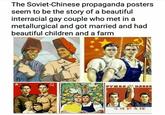War Propaganda Parodies
Part of a series on History Fandom. [View Related Entries]
[View Related Sub-entries]
About
War Propaganda Parodies refer to spoofs and satires based on a particular type of visual media, mainly posters and short films, that were mass produced and publicly distributed by numerous governments in the early 20th century, mainly for the purpose of promoting domestic support in mobilization efforts and/or demoting certain views held by enemies during wartime.
Origin
The concept of propaganda, which is broadly defined as any form of biased communication employed to influence public opinions through the power of persuasion, has been practiced for many centuries before the arrival of the modernity, most notably in times of religious and political reformations across Europe. However, the first large-scale and organized propaganda campaign was brought on by the outbreak of the Great War in 1914, during which both the British and German governments mass produced a series of posters, newsletters and even films to encourage voluntary recruitment of military forces and instill a strong sense of nationalism. Decades later, the use of propaganda grew and expanded drastically in the wake of the World War II, with the United States government leading the efforts by introducing nearly 200,000 different designs and messages for posters, radio broadcasts, films and newspapers, as well as other governments of both the Allies (United Kingdom, French Resistance, Soviet Russia) and the Axis (Nazi Germany, Italy and Japan).
Parodies
Following the defeat of the Axis Powers and the end of the war in 1945, the visibility of once-ubiquitous propaganda posters and leaflets began to wane rapidly, even in the times of the Korean War and the Cold War, in part due to the advents of television broadcast in the United States and Europe. Despite the steady decline of propaganda posters during the latter half of the 20th century, the cultural impact of propaganda posters continued to resonate throughout popular culture and ultimately gave rise to the recontextualization of their messages for comedic purposes. With the advents of the Internet and digital image-editing technologies at the turn of the century, the parody phenomenon entered a golden age on online humor forums and communities. On April 4th, 2002, Something Awful hosted one of its first propaganda-themed Photoshop Phriday events[1], drawing photoshopped parodies and satirical image macros based on various posters from both World Wars.
Spread
[researching]
- In 2009, Valve hosted a faux-propaganda contest for its Team Fortress 2 WAR! update. The purpose of the contest was to create a propaganda poster for the battle between the RED Demoman and the BLU Soldier, and most entries were done in styles heavily influenced by WWII propaganda art.[2] For a list of the most popular propaganda posters used as subjects of parodies and satires, please refer to the examples below.

Various Examples
Uncle Sam's "I Want You"
Some of the most recognizable propaganda parodies are based on the famous I Want You for U.S. Army poster featuring "Uncle Sam" that was produced and distributed during World War I. Created in 1917 by J. M. Flagg and inspired by the lesser-known British version, "Lord Kitchener Wants You,"[4] released in 1914, the poster depicts Uncle Sam pointing at the viewer and asking the public to enlist at the nearest United States Army recruiting station.[3]


Many derivatives of this poster exist, due to its easily-customizable nature. The first such derivatives predate the internet, and have found many applications during the Cold War and beyond. The internet has spread the image further, and today it remains arguably the most famous and influential propaganda poster.




"Keep Calm and Carry On"
One of the first World War II posters to achieve fame on the internet as an exploitable image is the Keep Calm and Carry On poster, printed by England's short-lived Ministry of Information in 1939. It was created to boost the morale of British civilians under the constant threat of a Nazi invasion.[5]

Its simple design and message have allowed it to be re-imagined countless times.




"We Can Do It!"
We Can Do It! is another very famous poster from WWII. It depicts a woman in overalls rolling up her sleeve and flexing her arm in a factory. It was created in 1942 for the War Production Coordinating Committee, and was based on a photo of a factory worker in Lansing, MI named Geraldine Doyle. During the war, women were employed as factory workers since all the men were fighting, and they were extremely productive and efficient. The poster represents the spirit of feminism and the power of women, and remains one of the most instantly-recognizable and widely-used propaganda posters today.[9]

Its notoriety has spawned many derivatives, often playing up the "can-do" attitude represented in the image, as well as the imagery of strength and power.



"When You Ride Alone, You Ride with Hitler"
When You Ride Alone, You Ride with Hitler is another example of a historical propaganda poster that has recently seen renewed interest due to being extensively parodied on the internet. It is typically used satirically due to the comically hyperbolic nature of its message.



U.S. Army Rationing Posters
The original untitled poster was created by the United States Office of War Information in 1943 to promote war time rationing in the US.[11] It has since been adapted to tell the viewer to "Shut the Fuck Up," and remains one of the most widespread macros, frequently being used on forums.


Communist Propaganda
During the World War II and the Cold War, the Soviet Union and China also produced massive volumes of propaganda materials, all with a very distinctive style which has come to be associated with communist countries in general. They often feature prosperous factory workers and farmers or triumphant soldiers.[10] These artifacts have also stayed relevant as some of the more popular sources materials for parodies and satires, because of their bold, simplistic designs. Many of the jokes in the posters are thematically similar to Soviet Reversal jokes.



The Solo Regiment
The Solo Regiment, also known as the People’s Party of Loneliness, is a Korean slang phrase, originating in 2003, that refers to a generation of singletons who spend too much time online. They have adopted Korean War-era propaganda to represent their plight, using Southern (capitalist) and Northern (communist) posters. The added captions draw heavily from the patriotic morale-boosting messages distributed during wartime, but twist the messages to apply to their solitude. There even exists a mock South-North rivalry between the Solo Regiment and the People's Party of Loneliness, with each side using its appropriate propaganda.



Search Interest
External References
[1] SomethingAwful – Photoshop Phriday
[2] Official TF2 Wiki – Propaganda Contest
[4] Wikipedia – Lord Kitchener Wants You
[5] Wikipedia – Keep Calm and Carry On
[6] Wikipedia – Barack Obama "Hope" poster
[7] Wikipedia – Barack Obama "Joker" poster
[9] Wikipedia – Rosie the Riveter
[10] Wikipedia – Communist propaganda
[11] University of North Texas – Digital Library
















Top Comments
Frappe Pony Bro
May 26, 2012 at 03:36PM EDT
Nedhitis
May 09, 2016 at 01:12PM EDT